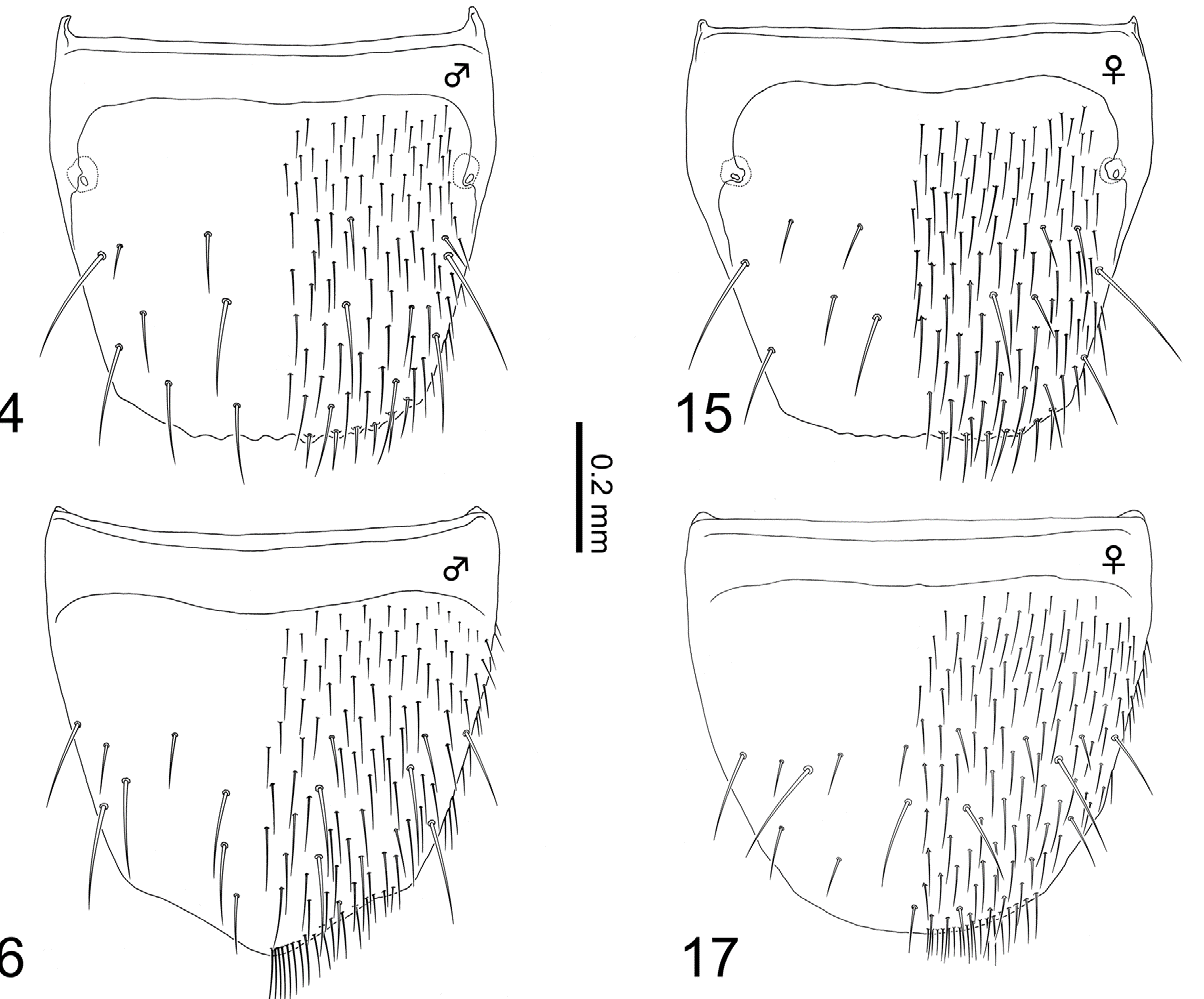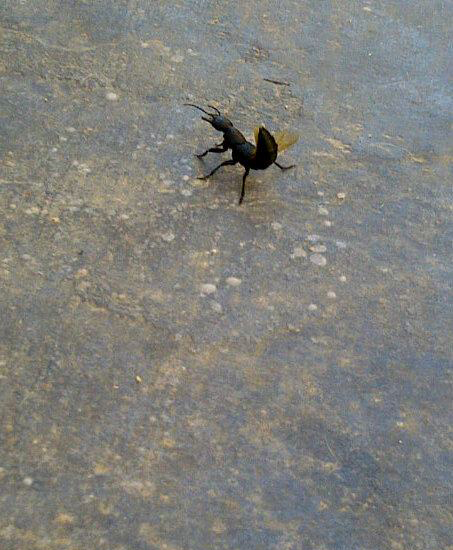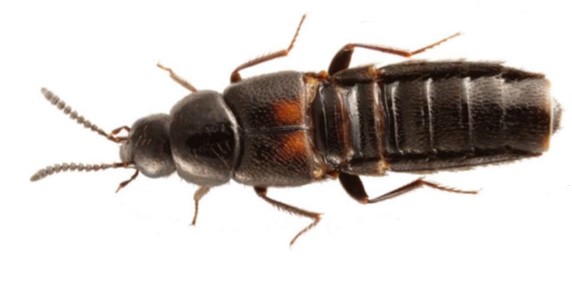Form and Function
A. bilineata adults are shiny
beetles, normally all black in color. They have pointed, narrow
abdomens. These beetles are very small,
only about 5-6mm long in total length (Shelton 2013). Rove
beetles have forewings and hind wings that are very small but
functional. They are active and strong fliers; adults can fly
up to five kilometers at a time (Gauvin 1998). One of the only
ways A. bilineata can be identified from related beetles is by
their short elytra. Elytra are a specific characteristic to
beetles and are defined as the hard outer wings that protect and
cover the thinner wings commonly used for flight
(Meyer 2009).
Besides their short elytra, there are not many differences
between them and their other beetle relatives. Male and female
of the A. bilineata species also are very difficult to tell
apart.
One wa y to differentiate between sexes of this species is male
A. bilineata have about sixteen small hair-like bristles
on their abdomen. On the other hand females have about twenty
bristles and they are longer than the male bristles
(Gauvin 1998).
Both sexes tend hold their abdomen aloft (like a scorpion) when they
are disturbed so they look bigger to their predators
(Shelton,
2013). Mandibles are located on the front of the beetle. They are
the mouthparts which are first used to create a hole in the host
puparium when the larva is ready to come out, and from then on they
are used for feeding on prey and feeling around in the soil
(Gauvin
1998).
y to differentiate between sexes of this species is male
A. bilineata have about sixteen small hair-like bristles
on their abdomen. On the other hand females have about twenty
bristles and they are longer than the male bristles
(Gauvin 1998).
Both sexes tend hold their abdomen aloft (like a scorpion) when they
are disturbed so they look bigger to their predators
(Shelton,
2013). Mandibles are located on the front of the beetle. They are
the mouthparts which are first used to create a hole in the host
puparium when the larva is ready to come out, and from then on they
are used for feeding on prey and feeling around in the soil
(Gauvin
1998).
Scientists have found that when the adult beetles emerge from the
host pupa, both male and female A. bilineata are almost exactly the
same weight. These weights directly correspond to the size pupa that
they had occupied during their larvae stage (Langlet 1998). So if
they spend the first stages of their life in a large pupa, the will
tend to be larger when they come out. After emergence, once they
start to feed, the female is generally a little larger in size
compared to the male. On average the female measures to be 5.81 mm in length while
the male only measures to be 5.40 mm. (Guavin 1998). This could be
due to the fact that the female starts ovulating and her eggs inside
her cause the slight increase in weight.
The females stay slightly heavier than the males for the first half
(30 days) of their life (Langlet 1998). After the first half of
their life, the female is mostly done laying eggs. Their weights
after the first 30 days of being adult beetles were similar again
(Langlet 1998).
male. On average the female measures to be 5.81 mm in length while
the male only measures to be 5.40 mm. (Guavin 1998). This could be
due to the fact that the female starts ovulating and her eggs inside
her cause the slight increase in weight.
The females stay slightly heavier than the males for the first half
(30 days) of their life (Langlet 1998). After the first half of
their life, the female is mostly done laying eggs. Their weights
after the first 30 days of being adult beetles were similar again
(Langlet 1998).
A. bilineata are known to have a large variation in mean sperm tail
length. The longer the sperm’s tail, the more force the sperm will
have. Therefore they would be more likely to be the first sperm to
get to the egg and fertilize it (Green 2002). Kieran Green, a
scientist from the Institute of Biology in Freiburg, Germany, did an
experiment trying to determine what to relate to the increased
length of the sperm tail from beetles such as A. bilineata. Was the
increase in length caused by the age of the male, the body size, or
the amount of sperm that already had been produced? Green’s motive
was to figure out if sperm length could be related to the male’s
current condition (nutrition, age, and immune system) or if it was
determined by ontological factors like body size or size of puparium
it inhabited (Green 2003).
Green found that it was clear that sperm did get longer as time in a
male’s lifetime went by. This is why there is such a variation in
lengh of sperm. Green stated, “To my knowledge, this is the
first time that an increase in mean sperm length over an animal’s
lifetime has been demonstrated” (Green 2003). On a larger scale,
this shows that female A. bilineata will be able to choose an older
male as her mate (Females are able to differentiate between old and
young males). Therefore, their offspring will have a selective
advantage over those offspring of females that mated with a younger
male because older males have already proved that they are
sufficient at finding food, avoiding predation, and that they have
good immune systems (Green 2003).
Check out our reference page for more information on our facts and sources!
For more information on where to find A.
bilineata, visit our habitat page.
Return home
